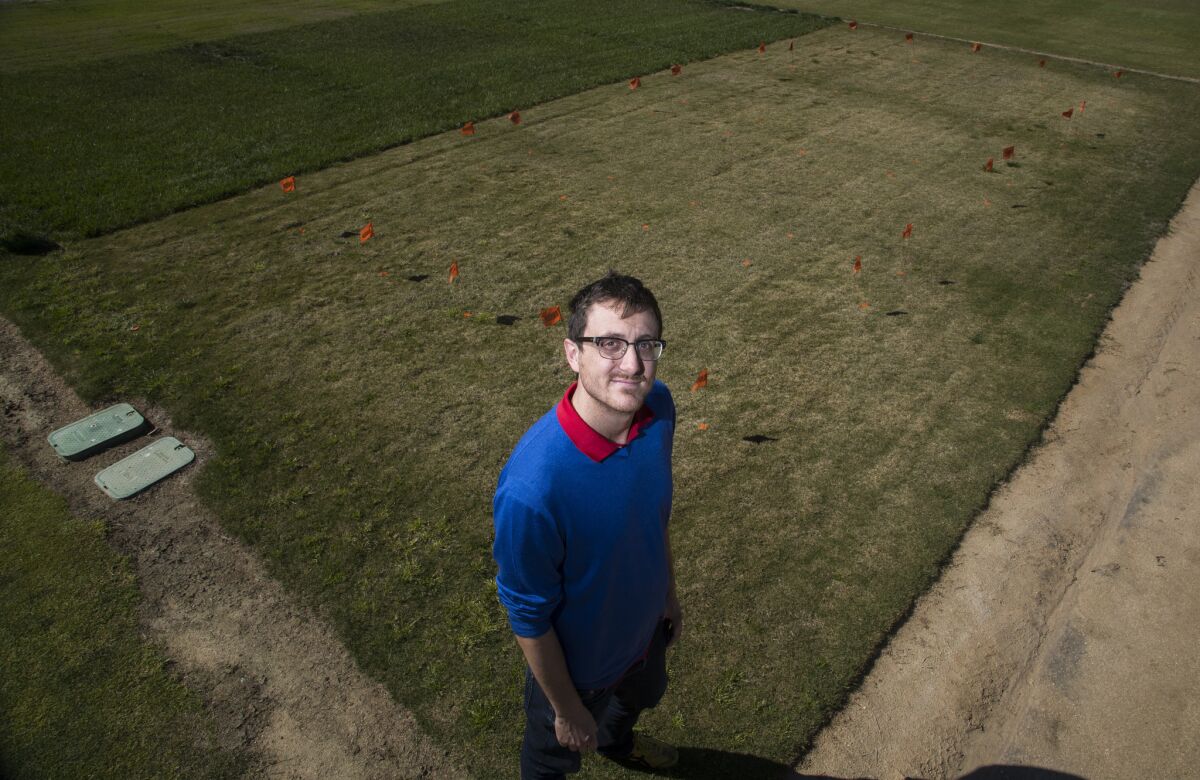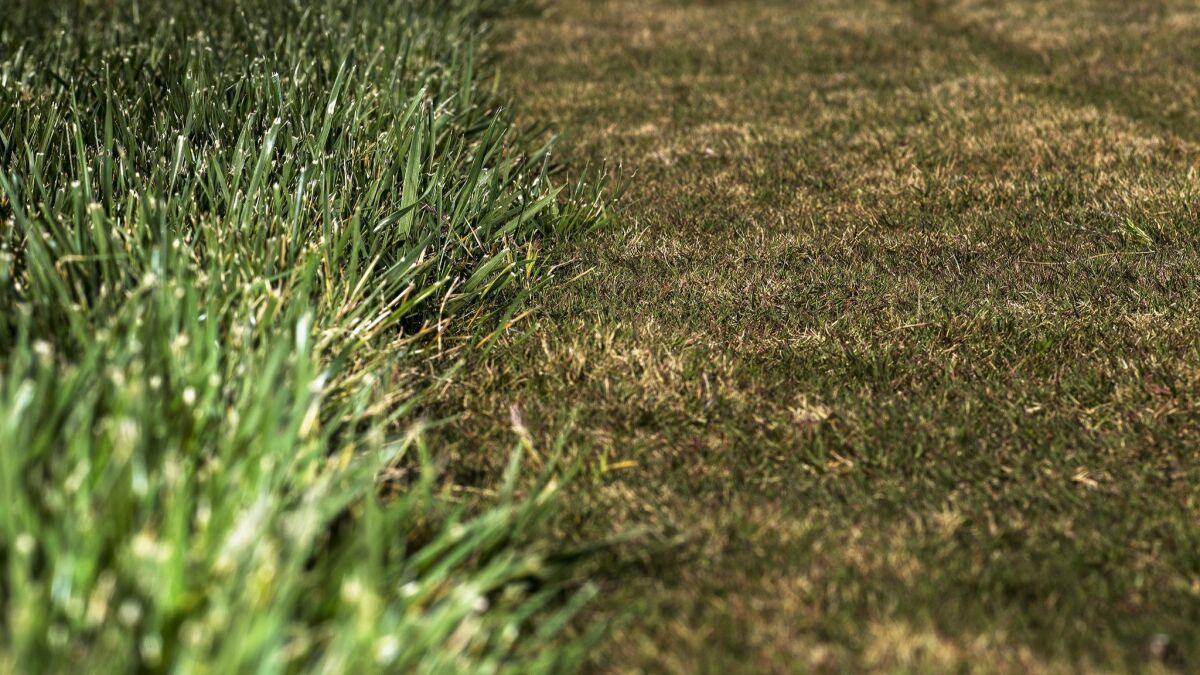How Long To Water Lawn In California
Attention, Southern California lawn owners: Cast off your cone of shame!
Yes, your lawn uses water — more than about that afterward — just when you sense judgment from the smug neighbour who replaced her lawn with colored rocks and succulents, don't lower your eyes and slink inside.
Instead, stroll over, sadly toe a few rocks and note how your backyard is combating the "urban heat isle result" by making the neighborhood cooler and reducing the state's need for electricity, most of which — ahem — is produced using water.
"'Turf' has go this four-letter discussion, merely our position is that turf doesn't waste water," said Jim Baird, a turf grass specialist at UC Riverside's Turfgrass Research Facility. "By removing turf, we're creating a situation that requires more energy to cool the environment, and well-nigh 2-thirds of energy production in the country requires water."

(Gina Ferazzi / Los Angeles Times)
The Ecology Protection Agency has found that air temperatures in hard-surface-areas of cities can be as much as 12 degrees warmer than in green areas, especially afterwards dusk, said Baird. About 5% to 10% of community-wide demand for electricity is used to combat the heat island outcome, he said.
And so keeping your backyard tin be very skillful for the surround, along with the more obvious benefits: erosion control, a reduction in dust, noise and fire danger, and that lovely odour when it's mowed.
Merely don't congratulate yourself just all the same. Most SoCal lawn owners waste product a lot of water, due to faulty irrigation and maintenance, said Baird and turf grass researcher Marco Schiavon.
It'south possible to reduce your h2o consumption significantly and still accept a salubrious lawn, even in the midst of drought-like weather, they said, but it means making some changes.
Here are their v acme tips:
1. Less is all-time with watering
Footstep 1: Think "deficit" irrigation, instead of "optimal" irrigation. That means learning how to utilise your sprinkler timer and turning off your irrigation in the cool months between November and April. When it warms upwardly, water deeply in the early morning or evening for x to xv minutes a maximum of three or 4 days a week, depending on your backyard type (3 days for warm-season grasses like Bermuda, four days for cool-season grasses like fescue). If runoff is a problem, separate your watering fourth dimension into three-minute cycles, Baird said. "Your backyard won't be super lush," he said, "but it will exist good enough."
2. Choose the right turf

(Gina Ferazzi / Los Angeles Times)
Most 90% of SoCal lawns are planted with deep-green fescue grass, Baird said, but warm-season grasses similar Bermuda or buffalograss need about 20% less water to stay green in hot, dry conditions. Call back three days of watering each calendar week for Bermuda grasses, versus iv days for fescue.
Bermuda lawns aren't pop because they go brown in the wintertime, when temperatures consistently dip below 80 degrees, but there are many varieties of Bermuda, Baird said, and UCR's Turfgrass Research Facility is developing new varieties that stay dark-green during its dormant flavour.
3. Feed your lawn
Lawns are greener and less weedy if fertilized four times a yr. ("The best herbicide is a salubrious turf stand," Schiavon said.) Grass only responds to nitrogen, Baird said, so other amendments aren't necessary. Baird recommends fertilizing fescue and other cool-season grasses around St. Patrick's Day, Memorial Mean solar day, Labor Day and Halloween. Bermuda and other warm-season grasses should be fed effectually Easter, Fourth of July, Labor Solar day and Halloween.
four. Mow wisely
Sharpen your mower blades at to the lowest degree in one case a yr (or make sure your gardener has sharp blades), because dull blades shred and stress the grass. Be sure you lot (or your gardener) is mowing to the right height — 3 to iv inches for fescue/cool-season grasses and just 1.5 to two inches for Bermuda/warm-flavor grasses. And exit the clippings on the ground, for proficient, free fertilizer. "I still tin't believe all the gardeners I come across collecting clippings to create more waste," Baird said.
5. Maintain your sprinklers

(Gina Ferazzi / Los Angeles Times)
People tend to h2o more when they run into brown spots on their backyard, Schiavon said. What they don't realize is that no above-footing irrigation arrangement provides 100% distribution, then information technology's improve to merely hand-water brown spots. Every leap, earlier yous resume regular irrigation, make clean or supercede the filters in your sprinklers and be sure they're working properly. Fixed-spray nozzles of the same size are more efficient than rotary blazon sprinklers, merely if you're replacing or installing a lawn, Schiavon says the most efficient system is sub-surface irrigation, a serial of PVC pipes with holes, spaced nigh one foot apart, 4 to 6 inches deep.
Source: https://www.latimes.com/home/la-hm-lawn-care-during-a-drought-20180922-htmlstory.html
Posted by: lopezgromemence.blogspot.com

0 Response to "How Long To Water Lawn In California"
Post a Comment